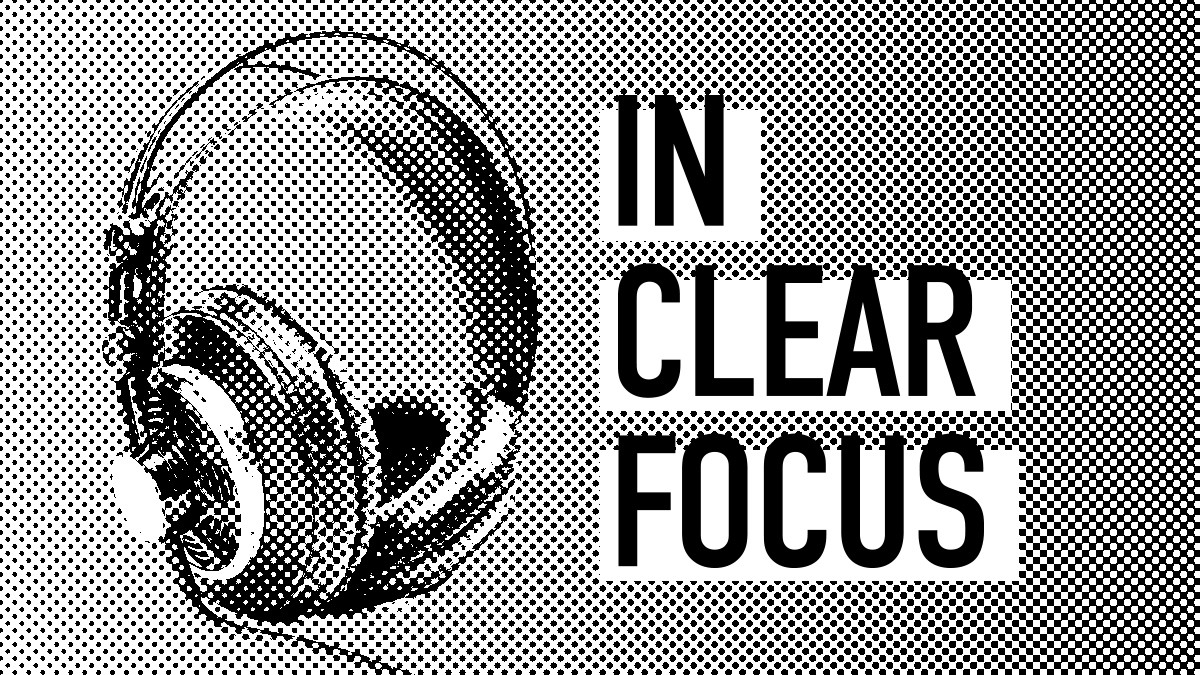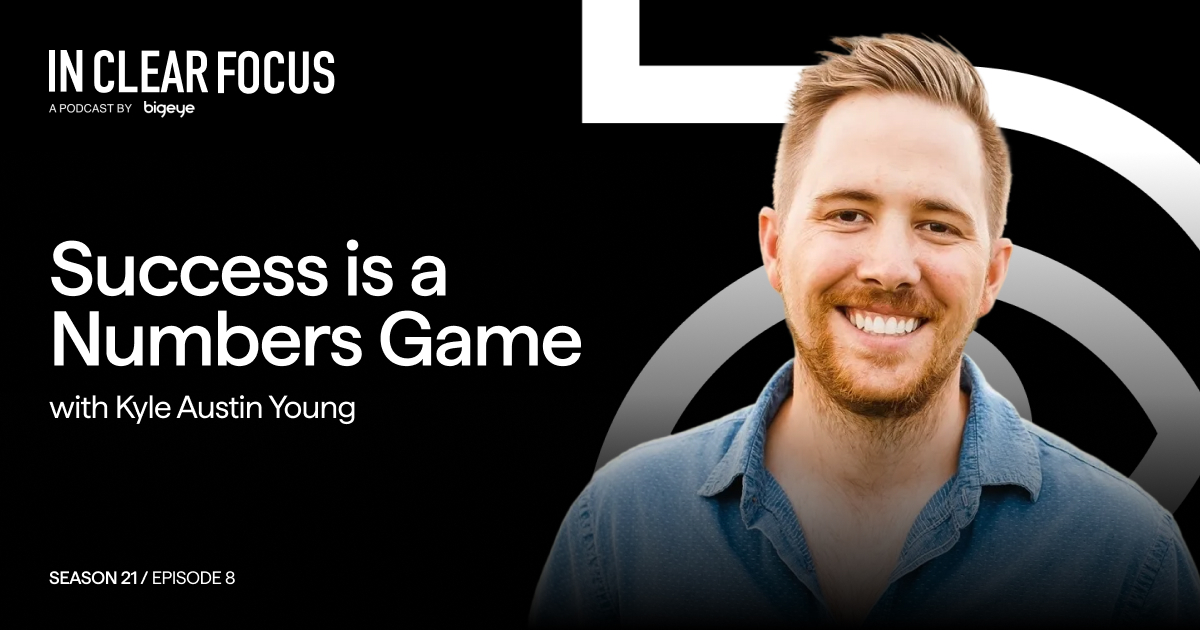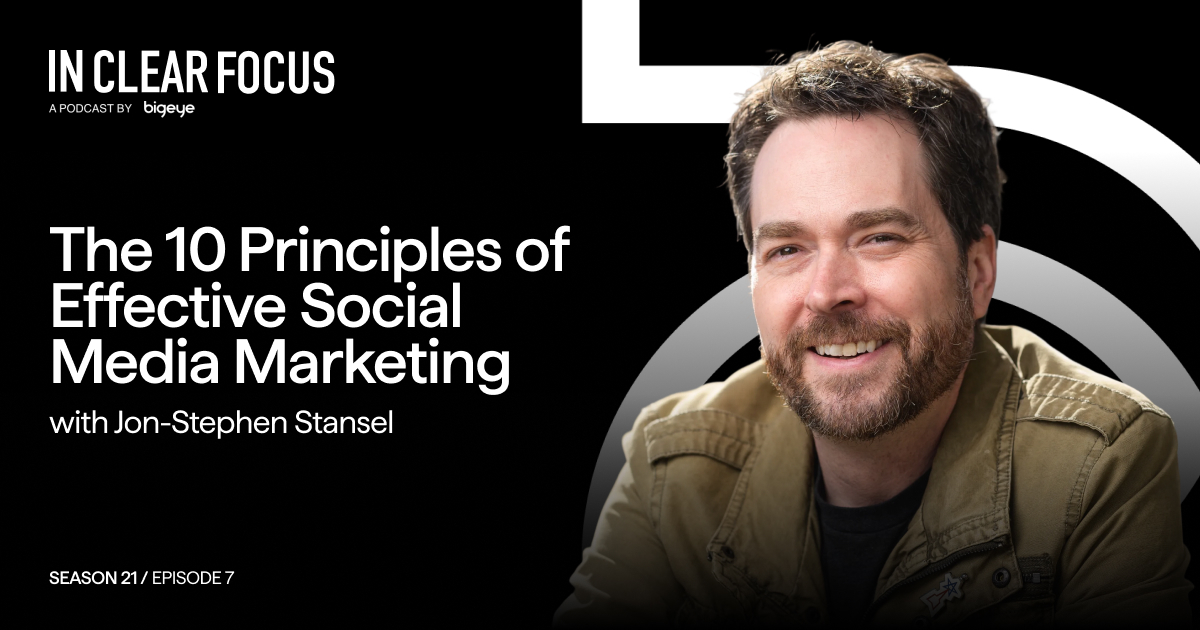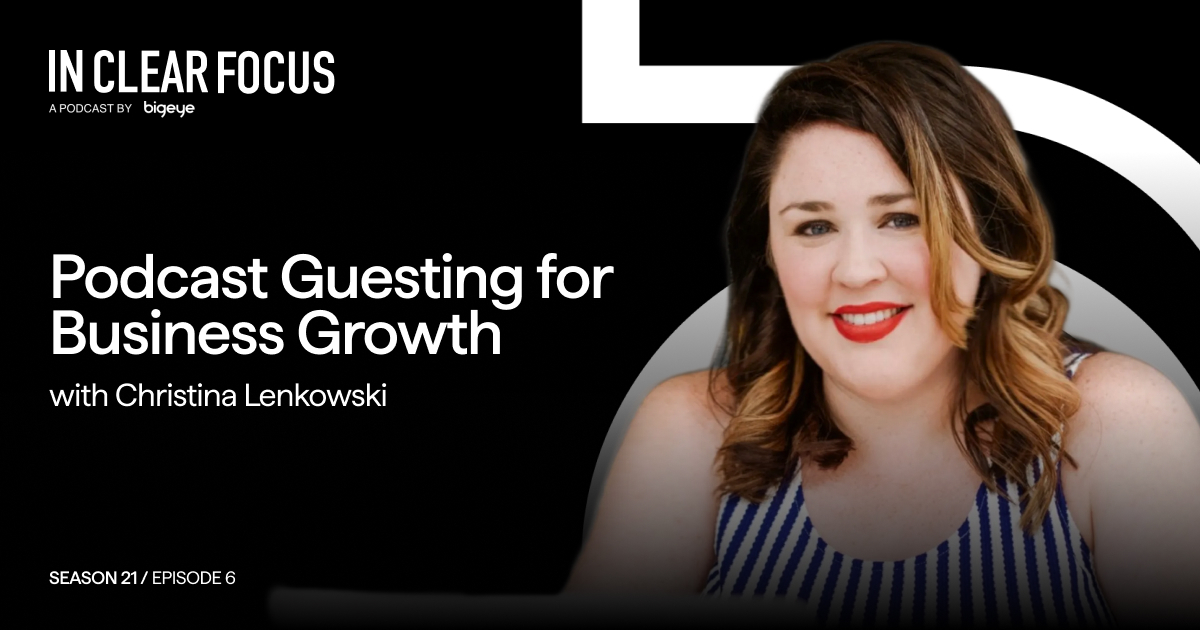The Bigeye team shares their favorite podcasts this week on IN CLEAR FOCUS. We explore a variety of topics, from folklore to World Champion Wrestling history.
IN CLEAR FOCUS: Members of the Bigeye agency team select their favorite podcasts. We learn how shows were first discovered, and why particular episodes were chosen for inclusion in our Spotify playlist. Our featured selections this week reveal the origins of scary stories from folklore, explore the exciting potential of gene editing in medicine, debate why things went wrong when The Warrior joined World Championship Wrestling in 1998, and teach how to generate stunning imagery with CGI software Houdini.
Episode Transcript
Adrian Tennant: You’re listening to IN CLEAR FOCUS, a unique perspective on the business of advertising. Produced weekly by Bigeye. Hello, I’m your host, Adrian Tennant, VP of Insights at Bigeye. An audience-focused, creative-driven, full-service advertising agency, Bigeye is based in Orlando, Florida, but serves clients across the United States and beyond. Thank you for choosing to spend time with us again today. A few weeks ago we discussed The Spoken Word Audio Report from National Public Radio and Edison Research. It revealed that the share of time spent listening to spoken word audio has increased by 20 percent since 2014 while time spent with music actually decreased 5 percent across the same period. Today, 22 percent of the US population listens to podcasts every week for an average of six hours, 37 minutes to about seven different shows. And 59 percent of spoken-word audio listeners are digital-first, meaning they listen mostly through computers, mobile devices and smart speakers. In addition to apps like Apple Podcasts, which is the most dominant player, listeners can access shows on streaming audio services, including iHeartRadio, Pandora, and Spotify, which recently redesigned its app to put podcasts front and center. So for this episode of IN CLEAR FOCUS, you’re going to hear what some of us at Bigeye are listening to. We have a Spotify playlist for you to explore, which we’ll talk more about at the end of today’s show. So let’s meet our first guest to this week’s IN CLEAR FOCUS.
Karen Hidalgo: I’m Karen Hidalgo, Associate Account Manager here at Bigeye. A little bit of what I do on my day to day is making sure projects and budgets are on track, making sure our clients are happy, projects are in production, making sure just everyone is happy and we’re treading along.
Adrian Tennant: Perfect. How long have you been at Bigeye?
Karen Hidalgo: I’ve been here for a year now.
Adrian Tennant: So what’s your preferred device for listening to podcasts?
Karen Hidalgo: Definitely the iPhone.
Adrian Tennant: Okay. And do you have a player or an app that you prefer or do you go to websites for your podcasts?
Karen Hidalgo: So Spotify is my primary.
Adrian Tennant: Now, when do you do most of your listening?
Karen Hidalgo: I would say probably here at work, if the podcast is really good, that particular episode, I will listen to it on my way home. Okay. Usually maybe at home, doing some cleaning, but the majority of it here at work.
Adrian Tennant: Do you have a favorite genre of podcast?
Karen Hidalgo: Probably nonfiction. Most of the ones that I subscribe to. I love thrillers, definitely like TED talks.
Adrian Tennant: How many do you subscribe to?
Karen Hidalgo: Maybe a handful. Honestly, not many.
Adrian Tennant: Now are you pretty religious about listening to those that you do subscribe to?
Karen Hidalgo: Yes. When they come out – some of them are biweekly – I’m definitely there.
Adrian Tennant: Today you’ve selected an episode of a show called, “Lore.” How did you find this podcast?
Karen Hidalgo: So Lore was the first podcast I ever started listening to. It was right out of college and podcasts were starting to be very big in the market and people were talking about it. So I went and did some research and I said, okay, well I’ve always liked thrillers. Scary stuff. Um, so I just happened to run into Lore and it turns out it’s also a show. And it’s also a book which I’ve had the opportunity to do both. And that’s kind of where my obsession with Lore started.
Adrian Tennant: Now you’ve selected an episode called, “A Stranger Among Us.” Sounds a little creepy, Karen.
Karen Hidalgo: So again, one of the first episodes I listened to happened to be at Christmas time and this particular episode deals with Santa and what he represents in the folklore of kind of other cultures and other countries. Again, kind of hinting at the scary but history of it. So it’s very intriguing. It kind of gives you a campfire experience. And he’s great at providing the historical facts. And that’s also a plus for me.
Adrian Tennant: I think I’m right in saying you were born outside of the United States as was I. Do shows like this give you kind of an extra insight into the workings of the American mind?
Karen Hidalgo: Absolutely. And I love, I mean, I’m from South America, but I love everything that has to do with America. But learning about other cultures through a podcast has given me definitely that glimpse, something that I have loved the most about listening to a podcast like this.
Adrian Tennant: Karen, why do you think our listeners should give this show a try?
Karen Hidalgo: I guess if you’re looking for something different, thrillers are not for everybody, but if you like history if you’d like to spice it up if you’d like folklore like I do. I think it’s great, it’s a great episode.
Adrian Tennant: So, Karen, I understand that Aaron Mahnke, who’s the host of this show, also has other podcasts. Have you listened to those as well?
Karen Hidalgo: Yes, I actually have. I’m one of them. I just started listening to Unobscured. It goes into the history of the witch trial and Salem, again, very history. He puts his very good spin on it, gives you a lot of facts. Great. Great. It’s just a great addition to Lore.
Adrian Tennant: Great. Thank you, Karen. Thanks for those recommendations.
Rhett Withey: I’m Rhett Withey. I’m the senior designer at Bigeye and I’ve been here for almost seven years now.
Adrian Tennant: Excellent. Rhett, can you tell us a little bit about what you do here at Bigeye?
Rhett Withey: Ah, let’s see. Well, I work with the Creative Director, Seth, on executing campaigns, logos, pretty much anything design and creative under the sun for our clients – and creative problem solving as well.
Adrian Tennant: Excellent. So how long have you been listening to podcasts?
Rhett Withey: Wow. Uh, I’d probably say right around the time that podcasts really started getting popular. I think it was like 2013, 2014, somewhere around there.
Adrian Tennant: What’s your preferred device for listening to podcasts?
Rhett Withey: I actually always almost exclusively listen to podcasts at my desk on my desktop.
Adrian Tennant: So do you have a particular favorite genre would you say?
Rhett Withey: I would definitely say that it’s pop culture and it’s sports, and it’s nerd stuff.
Adrian Tennant: Wow. Yeah. Well, that seems to very nicely sum up your selection if you don’t mind me saying so.
Rhett Withey: Okay.
Adrian Tennant: I hope I’m going to get this right. So, Rhett, you selected an episode of a show called, “83 weeks with Eric Bischoff.” And I must confess that I didn’t know who Eric Bischoff was. So you might need to explain that in a second. But the subtitle of the show is, “Fall Brawl 1998 (Warrior in WCW).” You’ve got to explain – what is this show about?
Rhett Withey: All right, there’s a lot to unpack here and I wouldn’t feel bad that you don’t know who that is because probably 90 percent of the population’s not going to know – it’s very insider. Eric Bischoff is the man that ran World Championship Wrestling in the mid-nineties and brought them to prominence and took over the number one rating spot from World Wrestling Federation at the time for 83 weeks. They had the number one show for 83 weeks, which is the name of the podcast. Fall Brawl is a specific pay-per-view event that they had and the Ultimate Warrior was a wrestler that they brought in. It was completely horrendous for what they were doing at the time and was pretty much the catalyst for them to no longer being number one.
Adrian Tennant: There’s actually quite a lot in this show, which I think would probably deserve a broader audience. So I don’t want to make it sound like it’s too nerdy. Rhett, what stood out to you about this particular episode?
Rhett Withey: Well the whole series is interesting because it’s kind of putting Eric Bischoff under a microscope and making him confess to his crimes. Right? So this particular one was interesting just because of bringing in and his explanation of bringing in this wrestler, the Ultimate Warrior, who is polarizing, even today. And why he thought that was a good idea and knowing that show and how much of a train wreck that pay-per-view actually was like hearing his explanations for things and why he went certain routes and, and trying to kind of listen to like, “Ah, I think you’re still covering your butt there,” was really fascinating.
Adrian Tennant: Were you an avid fan of the show when it was on TV?
Rhett Withey: Absolutely. Me and my, best friend Craig, every Monday night, we’re flipping back and forth between WWF and WCW. So we get to see the whole gamut.
Adrian Tennant: Right. Now, what was it about this particular episode that made it worthy of recommendation?
Rhett Withey: It really is just, it’s Eric’s trying to come to grips with especially knowing now how much of a terrible person the Ultimate Warrior was and him trying to rectify his choices by but still trying to come off clean and the in a sense. So it’s really an interesting listen to hear how he is trying to explain himself and trying to make everything seem not as bad as it actually was.
Adrian Tennant: Right. Thank you very much indeed for joining us on IN CLEAR FOCUS today.
Rhett Withey: Thanks, Adrian. It’s been great.
Lauren Fore: Hi, I’m Lauren Fore. I am the executive assistant to our owner and the leadership team, which can be a variety of different things based on the day, the corridor, the need. And also I help with a lot of internal marketing initiatives as well, blogs, things like that.
Adrian Tennant: Yes, you do. And everybody that’s listening should know that Lauren is responsible for uploading all the transcripts for this show every week and updating the website and the pictures and everything that comes with it. So thank you, thank you very much indeed Lauren – we appreciate it. Okay. Lauren, how long have you been listening to podcasts?
Lauren Fore: So the podcast that got me into podcasts, which I would venture to say is probably the one that got a lot of people into podcasts, was called, “Serial,” back in 20- I want to say 2013, 2014. That’s Serial as in serial killer, not Fruit Loops.
Adrian Tennant: Right!
Lauren Fore: Just to clarify! Every episode – it just sucked you in and you had to listen to the next and the next and the next. And it was just incredible. So I had not listened to a podcast before that and I didn’t listen to too many after actually, but that was the one that really got me into it. And I think a lot of people,
Adrian Tennant: So today, what’s your preferred device for listening to podcasts?
Lauren Fore: I would say 99 percent of the time on my iPhone. Rarely on my computer at work. I wish I had a brain where I could multitask between working and listening diligently to a podcast, but I just can’t. So it’s usually the commute to and from work. Sometimes if I have a long drive I’ll definitely listen to them. Helps pass the time. But yeah, always on iPhone.
Adrian Tennant: Do you have a favorite app that you use?
Lauren Fore: I use the actual podcast app on my iPhone.
Adrian Tennant: So how many shows do you subscribe to?
Lauren Fore: I really only subscribe to, “The TED Radio Hour.” That’s really the only one. But I’ll tell you why – it is so incredible. And if you go through the list of the different episodes, I mean such big topics like the power of design, what is beauty, how we love, I mean just these crazy topics that are just so high level, but they’re just so intriguing. They’re amazing.
Adrian Tennant: So Lauren, you selected The TED Radio Hour from NPR and the show title is, “What Makes Us … Us.” So what is the show about?
Lauren Fore: So we’re introduced to essentially four speakers and they all have given TED talks in the past. So first we hear from Sam Sternberg who studies gene-editing technology and he talks about the letters of DNA. So A, G, C, T, and each human has 3.2 billion of these letters. And if you were going to fill up a dictionary with all of them, it would be 800 dictionaries per person. And then he talks about this gene-editing tool called CRISPR CAS nine that he has been working on. And he says, “You know, if you wanted to go into said dictionary just as an example and eliminate the few letters that make you a morning person versus not a morning person or the shape of your nose or if you have Parkinson’s disease, you know, it’s like your genes are responsible for everything and everything can really be isolated, but it’s a needle in haystack.” So this CRISPR CAS nine tool is letting scientists basically go in and try to pinpoint where these different things are. Now he does note the caveat that it hasn’t been conducted in an actual human, it’s been conducted in human cells in a Petri dish. So we should, we should make that clear. But he does say that there’s hope that one day we could potentially do this in humans. And then there’s the argument of, well, do you want to do that? Are you messing with natural selection? At that point, you know how, how much do we want to mess with that? So he talks a little bit about that. And then we hear from Steven Pinker, who is a Harvard professor in psychology, and he talks about our circuitry in the brain, but also the nature versus nurture argument. So are we all born as blank slates? And if so, he talks about social engineering. Could we engineer a certain type of humankind, you know, if we’re all born the same? So he kind of talks about the nature versus nurture debate. And then he talks about identical twins in this experiment they did. Identical twins that grew up in different parts of the world. So one was raised Catholic in, I want to say Germany. The other was raised Jewish in – and I want to say Trinidad. So they bring them into this lab in Minneapolis, and again, they’ve never met. They’re wearing the same shirt, same Navy shirt with the same epaulets. Then they start realizing that they’re both wear rubber bands around their wrist. They flush the toilet before and after using it, they dip their toast in coffee. All these little things and it’s like these are two people who have never met grew up in completely different environments, but they have the same genes. So there are arguments for both sides, but he goes into that. So that was really interesting to me. It’s so deep.
Adrian Tennant: It is deep. It leaves you with deep thoughts about the human condition for sure. And I think a lot of the TED Radio Hour actually leave you with questions, but in a good way. Now, what made this particular episode a favorite for you?
Lauren Fore: One of the first ones that I listened to, and this was probably one of the deeper ones that got me really hooked on this series.
Adrian Tennant: So you would give this a strong recommendation for listeners?
Lauren Fore: Very strong – if you want your mind blown!
Adrian Tennant: Yeah. Okay. All right. Lauren, thank you so much for being on IN CLEAR FOCUS on this side of the microphone for a change.
Lauren Fore: Thanks so much for having me. It was fun.
Adrian Tennant: I’m joined today by Dominic Wilson.
Dominic Wilson: Yeah. Hi. I’m the senior multimedia designer here at Bigeye and I’ve been here roughly a year.
Adrian Tennant: Can you tell us a little bit about what your role is at Bigeye?
Dominic Wilson: I create motion graphics, 3-D design and animation as well as video editing and photography for our campaigns.
Adrian Tennant: How many shows do you think you subscribe to?
Dominic Wilson: Zero.
Adrian Tennant: Okay! Now I think your selection for today’s podcast is a little different from some of the other folks at Bigeye. I’m guessing you kind of do have a favorite genre of podcast. I would say kind of educational, right?
Dominic Wilson: Yeah, that’s true. I suppose a, I mean it is in the creative field in regards to software and designs. So for me, I just am extraordinarily fascinated by those topics.
Adrian Tennant: You have selected an episode of a show called, “Greyscale Gorilla Podcast,” and I should explain that the description is a show for creatives who want to learn about motion design, 3-D rendering, Cinema 4D, working with clients and much more. So how did you find this podcast?
Dominic Wilson: I’ve been a fan of Nick Campbell going back to his Creamy Orange Portfolio days. And then he began creating little tips and tutorials, teaching you how to do things in a software program called After Effects. And then he just started doing libraries of tutorials on a 3-D application called Cinema 4D. And I was just hooked.
Adrian Tennant: Well I dipped into this podcast but I was fascinated that there’s an industry insider who gives lots of examples right at the beginning of the podcast and movies that I’ve heard of that this software has been used on. So to help us orient ourselves, could you just give us an overview of what’s in the particular podcast episode that we’re linking to in the show notes today?
Dominic Wilson: This particular episode spoke with Russ Gaultier who works with a software program called Houdini. And it was interesting to hear the insights whether or not it’s something that you have to learn as a motion designer. It’s kind of nice to hear someone who’s seasoned, kind of break it down for you.
Adrian Tennant: Now this is an audio podcast describing software. So how well does that translate, because I think of learning software as a somewhat visual skill – how well do you think it translates to an audio format?
Dominic Wilson: Well I think anyone who would probably seek out this particular podcast is probably going to have somewhat of a hands-on working knowledge of the program already. They do provide a lot of very helpful links to see the work that the artists did. They have an abundance of examples and things that you can see what they’re doing and if you’re familiar even in just some of the graphic design applications, they’ll still be a lot of things that probably can kind of connect some dots for you.
Adrian Tennant: Okay. What made this episode a particular favorite for you?
Dominic Wilson: I simply love the artists that in my opinion make the unreal real like Russ Gaultier who was a guest on that Greyscale Gorilla episode as well as some additional Houdini users like Joe Pascal, Eric Ferguson, and the gents over at Entagma to name a few.
Adrian Tennant: So there you go. Dominic’s recommendation is the Greyscale Gorilla podcast which gives you a peek into the world of those amazing visual effects. Thank you very much indeed for joining us today.
Dominic Wilson: Yeah, no problem.
Adrian Tennant: My thanks to everyone at Bigeye who shared their favorite podcast with us. To support this week’s show, we’ve created a Spotify playlist that includes all the full-length episodes of the podcasts we talked about today. You’ll find a link to that on the IN CLEAR FOCUS page at bigeyeagency.com under Insights. I hope you’ll enjoy checking out some of the podcasts we talked about. We’ll be back with some more listening suggestions next week for our final show of 2019. Until then, please consider subscribing to IN CLEAR FOCUS on Apple Podcasts, Google Podcasts, Spotify, SoundCloud, or your favorite podcast player. And if you like what you hear, do rate the show and leave a review you’ve been listening to in clear focus, a unique perspective on the business of advertising produced by Bigeye. I’ve been your Adrian Tennant. Thank you for listening and until next week, goodbye.
Featured Podcasts
- Lore: A Stranger Among Us
- 83 Weeks with Eric Bischoff: Fall Brawl 1998
- The TED Radio Hour from NPR: What Makes Us … Us
- Greyscale Gorilla: Going from Cinema 4D to Houdini
- Bigeye’s Favorite Podcasts: Spotify Playlist




